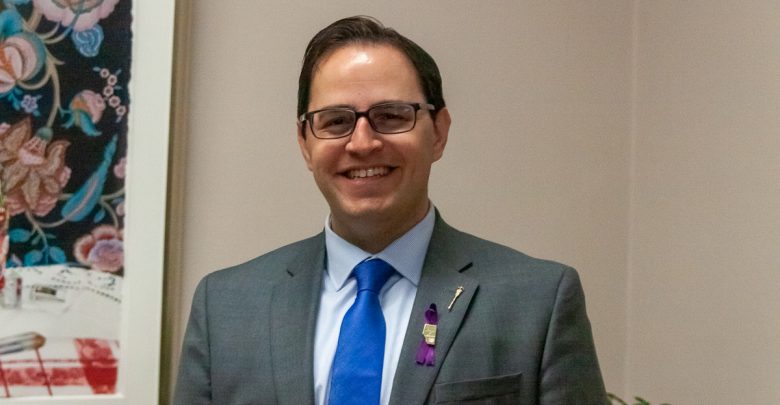Performance-based funding: A conversation with Minister Demetrios Nicolaides
Nicolaides says there is enough time for consultation to happen and for universities to prepare themselves for the April 1 rollout of performance-based funding
 Andrew McWhinney
Andrew McWhinneyThe United Conservative Party unveiled a new way of funding Alberta post-secondary institutions which will significantly alter their relationship with the government.
At a press conference in Calgary on January 20, Minister of Advanced Education Demetrios Nicolaides announced the changes, which he described as a “transformation” for the publicly funded post-secondary system. Beginning on April 1, 15 per cent of funding institutions receive from the province will be tied to performance metrics for 2020-21. This percentage will rise over the next three years to a maximum of 40 per cent.
Additionally, universities will sign investment management agreements which will outline goals and expectations from government of how the institution will perform for a three-year period. These negotiated agreements will establish specific performance targets for each institution and specify the amount of funding they will receive if they meet their targets.
According to Nicolaides, these changes will connect students with better employment opportunities and give taxpayers “more value.” For some stakeholders, the changes have caused concern.
The Gateway interviewed the minister to see his reaction to the recently announced changes, if there is enough time to roll out this model, more specifics about investment management agreements, and what would happen if institutions did not meet their specific targets year-after-year.
These interview responses were edited for clarity and brevity.
The Gateway: What has been the reaction to your government’s announcement to change to a performance-based model to determine post-secondary funding in Alberta?
Nicolaides: The reaction has been quite positive. We had some positive statements from some of our student groups, primarily the Alberta Students’ Executive Council. I know that the Council of Alberta University Students (CAUS), I believe, are cautiously optimistic and have expressed some interest in how the metrics will unfold. Not to mention, other statements of support from some of our post-secondary institution presidents, and reactions from others I have heard while being on some radio stations and news channels.
What do you think of the timeline of implementing performance-based funding for Alberta post-secondaries for April 1, 2020? Some have expressed concern over how tight this could be.
I am confident it will be enough time for us to implement the changes that we need to. This is precisely why we are taking a gradual approach to implementing the new funding model. I know that on Monday [January 20] I spoke about the possibility of having a total of 20 metrics. We absolutely will not be going to 20 metrics overnight. We will gradually get to that number over the course of three years. For us to begin, we will use a small number of metrics and gradually introduce them over the next three years.
What will the consultations you have promised regarding this change look like?
I am meeting with student leaders next week to talk primarily about performance-based funding. Officials from my department are busy scheduling meetings with post-secondary institutions and senior administrators so that we can begin the process of building the investment management agreements and finalizing targets. Furthermore, I have extended an open invitation to our students and to faculty representative groups — not just from now but going back several months — to provide any feedback or thoughts as it relates to performance-based funding. We’ve been in constant dialogue with students, faculty representative groups, and our post-secondary institutional leaders throughout this entire process.
I am looking forward to having some open conversations with student leaders and faculty representatives. If there are metrics or indicators students believe would be great metrics or indicators for us to look at or evaluate as part of this new model, I am very interested in hearing from them.
What will the investment management agreements look like? Will they be something that is negotiated and set in stone, or evaluated on a rolling annual basis? Will they be public, or held in trust between the government and that specific institution?
The agreement will cover a three-year period. But the specific metrics and the weighting accorded to each metric could potentially change from year-to-year. The intent in these agreements is to detail how the weighting of each indicator will change over the course of the three years. For example, in year one of the agreement, there is a stronger weighting on enrolment, but by year three the weighting will decrease on that indicator and increase on research capacity or quality of teaching. The investment management agreements will outline a roadmap so that institutions can have clarity about what government priorities and direction are.
Negotiations are well underway or should be commencing. As per my announcement on January 20, officials are working to connect with senior administration at our post-secondaries to begin the process of providing a venue for dialogue and to begin drafting these agreements.
The intent at this point is to make these agreements public.
Under this new funding model, is it possible for an institution to receive a net increase in funding?
There is a possibility. That is still one of the questions we are exploring. Of course, any increase would have to happen in the context of one institution not meeting their targets and another does, or exceeds it.
That is a very worthwhile discussion to have with the post-secondary community.
Some students are worried this type of model will force institutions who do not meet targets, and therefore, not receive the amount of funding they need to operate offloading this cost onto students. Could you see this occurring?
If an institution does not meet its target they will receive funding that is proportional to their achievement with respect to that target. For example, if the U of A had a target of increasing enrolment by 1,000 students, and they only got 80 per cent of the way there they would only receive that proportion of funding. But at the same time we would calculate and establish threshold tolerance bands around the targets so that, again, if the target was to increase enrolment by 1,000 students and they only got 998 that would very well fall within an acceptable tolerance level where they would still receive full funding.
The official opposition has said that this type of model is an infringement on post-secondary institutions’ autonomy — something Alberta institutions have had for a long time. How do you respond to that criticism?
No, not at all. I don’t understand the context of the criticism. Government’s are consistently engaged in the practice of providing direction to post-secondary institutions. I believe our new approach will give institutions more autonomy and greater flexibility because we are trying to move out of an annual cycle of providing government funding to our institutions.
Right now we issue institutions grant agreements every year to outline what our expectations are as to how they use those government dollars. To move away from that model and move to a more long-term three-year model where we can provide them greater clarity over a longer period of time as to what government expectations are, and allow them to do what they do best.
I completely disagree with those comments from the opposition. I think it just demonstrates that they don’t understand how this model will work.
Under this type of funding arrangement, doesn’t there exist a potential where a cyclical problem of underperforming institutions receiving less than what they need and continuing to not meet outlined targets?
That would only occur if the target or indicator remained constant. However, if an institution failed to meet a target year-after-year than there’s the possibility that the target in question can be moved or lowered. The comment that you made, that only exists if the target remains constant and does not change. This is precisely why I wanted us to create investment management agreements and we develop performance-based funding in a way that is tailored to each individual institution. Each individual institution cannot meet the same benchmarks with respect to research funding or international student enrolment. Our institutions are quite unique. That is why we need to establish benchmarks relevant to each individual institution.
Have you, any official within the government, or the Ministry of Advanced Education been in touch with the Doug Ford government in Ontario, who have also recently unveiled performance-based funding for their post-secondaries?
I have in fact haven’t had any conversation myself, personally with anyone in Ontario. I’ve taken a very close look at performance-based funding around the world. I’ve looked at models in Hong Kong, Tennessee, and other jurisdictions in Europe to inform the future policy direction we have undertaken.
What’s been the biggest takeaway from that survey of different performance-based models around the world?
The first piece was the investment management agreements. I found that many jurisdictions had similar versions. Some were three, four, or five years in duration. But they all approached it from the same perspective. That made me think more about the relationship between government and post-secondaries, and how many jurisdictions around the world are moving to a situation where they can move to a more long term relationship. I believe that is something we could accomplish as well.
Secondly, I also found a lot of overlap with respect to metrics many jurisdictions use. Many of the ones I looked at, whether it was Hong Kong or Norway, evaluated many of the similar metrics we are proposing as well.




